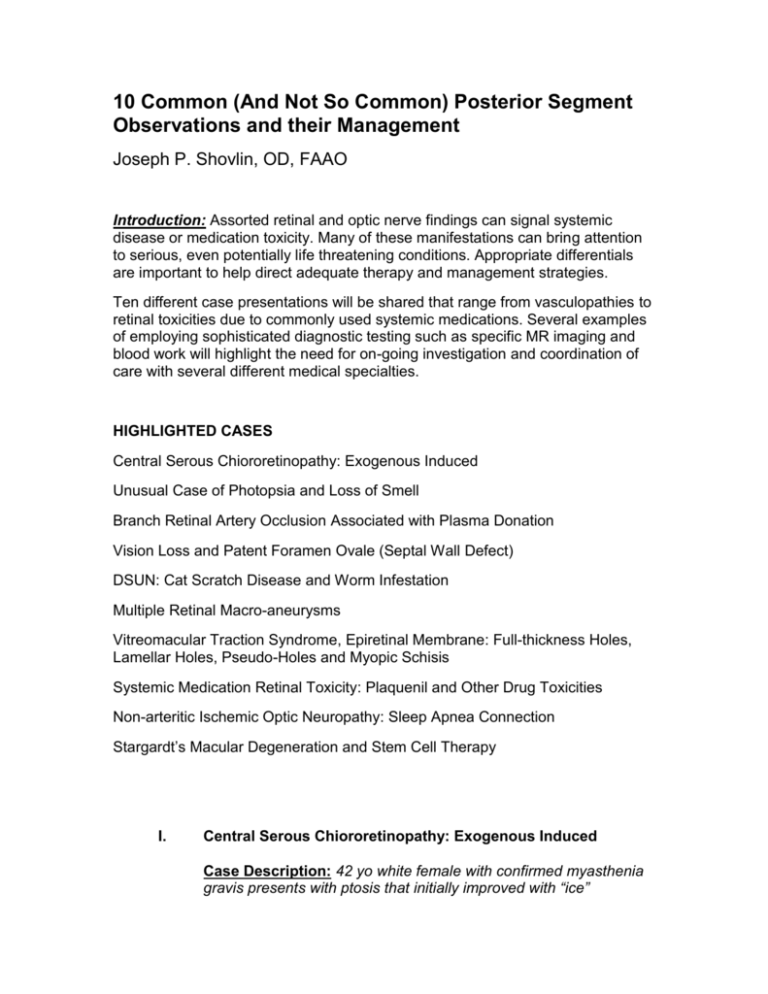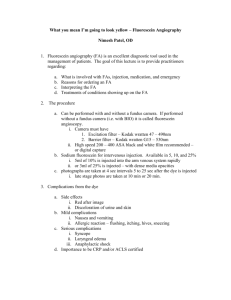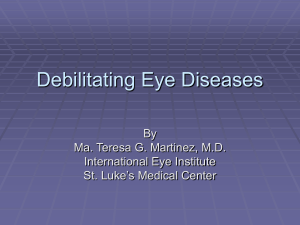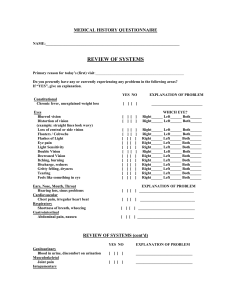PS-08 Outline
advertisement

10 Common (And Not So Common) Posterior Segment Observations and their Management Joseph P. Shovlin, OD, FAAO Introduction: Assorted retinal and optic nerve findings can signal systemic disease or medication toxicity. Many of these manifestations can bring attention to serious, even potentially life threatening conditions. Appropriate differentials are important to help direct adequate therapy and management strategies. Ten different case presentations will be shared that range from vasculopathies to retinal toxicities due to commonly used systemic medications. Several examples of employing sophisticated diagnostic testing such as specific MR imaging and blood work will highlight the need for on-going investigation and coordination of care with several different medical specialties. HIGHLIGHTED CASES Central Serous Chiororetinopathy: Exogenous Induced Unusual Case of Photopsia and Loss of Smell Branch Retinal Artery Occlusion Associated with Plasma Donation Vision Loss and Patent Foramen Ovale (Septal Wall Defect) DSUN: Cat Scratch Disease and Worm Infestation Multiple Retinal Macro-aneurysms Vitreomacular Traction Syndrome, Epiretinal Membrane: Full-thickness Holes, Lamellar Holes, Pseudo-Holes and Myopic Schisis Systemic Medication Retinal Toxicity: Plaquenil and Other Drug Toxicities Non-arteritic Ischemic Optic Neuropathy: Sleep Apnea Connection Stargardt’s Macular Degeneration and Stem Cell Therapy I. Central Serous Chiororetinopathy: Exogenous Induced Case Description: 42 yo white female with confirmed myasthenia gravis presents with ptosis that initially improved with “ice” application and acuity loss. Her medications now include Cellsept, oral Prednisone 80mg, and a proton pump inhibitor. Central serous chorioretinopathy was diagnosed based a classic retinal finding of serous detachment confirmed on OCT assessment. CENTRAL SEROUS CHORIORETINOPATHY Characterized by serous retinal detachment, one or more RPE detachments and is most commonly encountered in men (6:1) ages 25-50. Risk Factors Use of corticosteroids (oral), Type “A” personality, Cushing’s disease (cortisol levels). Diagnostic Tests OCT shows RPE detachment associated with a larger area of retinal serous detachment. Intravenous fluorescein angiography demonstrates a focal area of hyperfluorescence (sometimes assumes a “smokestack” pattern). Treatment Spontaneous reabsorption occurs in 85% of cases, laser can be applied in those where the sub-retinal fluid has not reabsorbed by 3-4 mos., ICG angiography guided half-fluence photodynamic therapy with verteporfin can be employed when lesion is within 750 microns from the fovea, anti-VEGf intravitreal injections can be considered. There may be increased risk of SRNV with laser photocoagulation therapy. PEARLS: Look carefully at the optic nerve for a congenital pit that has leaked. Choroidal neovascularization is possible especially with chronicity, so careful evaluation for signs of SRNV is prudent. Consider early laser therapy to larger RPE leaks seen in association with bullous serous chorioretinopathy. 90% of eyes regain 20/30 vision or better by 6 mos. II. Unusual Case of Photopsia and Loss of Smell Case Description: 64 yo white female presents with bilateral, central flashing lights of short duration and a generalized loss of smell. PCP ordered an MRI of brain with and without contrast dye that was read as normal. No additional testing was ordered. UNUSUAL CASE OF PHOTOPSIA AND LOSS OF SMELL Causes for entopic phenomenon: flashing lights/photopsia/phosphenes -vitreous traction/tear/break, Grave’s thyroid ophthalmopathy, IOL dysphotopsia, melanoma, CAR retinopathy; vascular-migraines, carotid stenosis, temporal artery inflammation; medication related (Clomiphene citrate, quinine, digitalis, Seroquel); and neurologic-seizure disorder, MS, temporal-occipital lesions/aneurysm. Adequate history should include: Location of the flashes Do they occur in one or both eyes? How long do they last? What is the color of the flashes? Does the patient have associated eye or medical conditions? Is the patient taking any medications? MRA imaging may detect an aneurysm when the MR is read as being normal. (aneurysm was missed due to movement even with fine cuts and observer missing lesions. III. PEARLS: Consider additional tests when symptomatology warrants, even when the insurance carrier bulks. MRI and MRA imaging is often not sensitive enough to detect certain brain pathologies. Flashing lights may indicate neurologic concerns especially with a normal retinal exam. Branch Retinal Artery Occlusion Associated with Plasma Donation Case Description: A 27 yo female presents with a complaint of reduced acuity and “blind spot” just off the center of her vision. She noticed this shortly after donating plasma, something she does twice a week for extra income. The nurse at the donation center mentioned that her blood pressure was quite low but that it would not impact her ability to donate plasma. BRANCH RETINAL ARTERY OCCLUSION ASSOCIATED WITH PLASMA DONATION Description Occlusion of the central retinal artery or one of its branches leads to an acute, painless, monocular loss of vision. Risk Factors Hypertension, diabetes mellitus, carotid artery arteriolarsclerosis, cardiac valve disease, hypercoagulable states Etiology Embolus (calcific, cholesterol, platelet fibrin, septic, cardiac myoma, talc/IV drug users Intravascular thrombosis Vasculitis-GCA Trauma Vasospasm Hypercoagulable states- antiphospholipid antibody syndrome, oral contraceptives, polycythemia Other systemic conditions-collagen vascular, syphilis, sickle cell anemia, Bechet’s Physical Exam Blood pressure, listen for murmurs, bruit, whitening and opacification of the inner retina in the vascular territory affected, embolic material may be visualized or “boxcarring” Diagnostic Tests CBC/platelets, ESR, C-reactive protein, fibrinogen, lipid profile, fasting blood sugar, others tests based on suspected etiology Diagnostic Procedures: carotid ultrasound/MRA/CTA, visual field testing, echocardiogram, electrocardiography, temporal artery biopsy (if GCA is suspected). Treatment Reduce IOP, AC paracentesis, ocular massage, thrombolytic agents, aspirin, oral/IV steroids for GCA Patient Monitoring Follow for neovascularization and glaucoma, follow acuity (BRAO may recover to a reasonable good level) PEARLS: IV. Giant cell arteritis accounts for 1-2% of cases of central retinal artery (vasculitis etiology=no embolus seen) IV drug use may result in artery occlusions (talc emboli) BRAO can be asymptomatic Vision Loss and Patent Foramen Ovale (Septal Wall Defect) Case Description: 63 yo white male presents with a recent bilateral reduction in acuity and a noticeable loss of peripheral vision to the right. Visual field testing showed a right congruous homonymous hemianopsia. An immediately obtained MRI/MRA of the brain showed a recent infarct of the occipital lobe without any aneurysm noted. Initial cardiac and vascular work-up including carotid ultrasound, trans-esophageal echocardiogram and appropriate blood-work. VISION LOSS AND PATENT FORAMEN OVALE Patent Foramen Ovale (PFO) A patent foramen ovale is a defect in the septum (wall) between the two upper (atrial) chambers of the heart. The defect is an incomplete closure of the atrial septum that results in the creation of a flap or a valve-like opening in the atrial septal wall. A PFO is present in everyone before birth but seals shut in about 80%. (http://myclevelandclinic.org/disorders/) When blood moves from the right to left atrium, bypassing the lung filter, if debris is present in the blood (such as small clots), it now passes through the left atrium and can lodge in the brain, causing a stroke, or another organ (including the eye). Fortunately, PFO usually cause no symptoms. Far less than 1% has a stroke or other outcome that results in a need for PFO closure (catherization). Diagnostic Tests Echocardiography (trans-esophageal), Doppler ultrasonography (trans-cranial), cardiac magnetic resonance imaging, and cardiac catherization. Treatment The usual care for a patient who has had a stroke is the use of blood-thinning medications, such as aspirin or the drug warfarin or clopidrogel. For those who can’t take blood-thinning drugs or those who have experienced a second stroke while on blood-thinners is a non-surgical closure of the hole (catheter based). Pearl: Cardio-vascular evaluations such as carotid ultrasound and echocardiography are many times negative. Echocardiogram (including trans-esophageal) is investigator dependent and may not detect septal wall defects. Trans-cranial Doppler is a more sensitive measure and easier to perform for septal wall defects. V. Neuroretinitis: Cat Scratch Disease Case Description: A 30 yo white male presents with reduced acuity in one eye. He described an antecedent flu-like illness 2 weeks prior with high fever and malaise. A dilated examination showed a neuroretinitis. After appropriate treatment the condition and acuity fully resolved. BARTONELLA (CAT SCRATCH) NEURORETINITS Description Neuroretinitis is a condition characterized by optic disc swelling and hard exudates distributed in a star-like fashion around the fovea. Risk Factors History of contact with a cat or kitten. Etiology Bartonella henselae, syphilis, viral, toxoplasmosis, toxocariasis, histoplasmosis, Lyme disease and systemic inflammatory conditions such as sarcoidosis. History Animal contact, travel, ingestion of uncooked meat, sexual history, systemic complaints (fever, malaise, headache, muscle ache). Physical Examination Optic nerve edema (color defects, reduced acuity, afferent pupil effect, pain on eye movement), vitreous inflammation, discrete, small yellow/white choroidal infiltrates, retinal occlusions are possible. Patients with cat scratch may be asymptomatic or exhibit lymphadenopathy, arthritis, meningitis, or encephalitis Diagnostic Testing Serology or ELISA for Bartonella henselae Treatment Cat scratch disease- Ciprofloxacin 750mg PO b.i.d. for 3 weeks (also doxycycline, erythromycin, azithromycin, rifampin) PEARLS Neuroretinitis is characterized by optic nerve swelling and exudative macular star. Bartonella henselae is the most common causative organism for infectious neuroretinitis. Cat scratch can present in asymptomatic individuals with a multifocal choroiditis. Other causes include nematode infestation (DUSN) and Lyme disease. VI. Multiple Retinal Macro-Aneurysms Case Description: An 80 yo white female presents with markedly reduced acuity in one eye of recent duration. She is taking multiple medications for hypertension. Her BP on this visit was 160/98 RA. Her retinal shows multiple macro-aneurysms with collected blood in the macular region. She declined any surgical evacuation for blood removal. MULTIPLE RETINAL MACRO-ANEURYMS Description Acquired retinal macroaneuryms are focal dilations of retinal arterioles within the first 3 orders of branching of the arteriole system. Commonly found in the superiorotemporal arteriole typically at AV crossings or arteriole bifurcation (proclivity for visual impairment). 2 types- (1) saccular- acute decompensation with variable degree of hemorrhage (2) fusiform- chronic exudation of plasma constituents. Serous retinal detachment, lipid exudation, and/or macular edema may be present. Epidemiology 10% are multiple; 20% are bilateral. Risk Factors Systemic hypertension (75%) Hyperlipidemia Cardiovascular disease Age (>60) Sex (60-80% female) Retinal Vein Occlusion (12X higher prevalence of macroaneuryms in area of occluded vein) Diagnostic Tests: OCT/IFVA, careful monitoring of BP Differentials: diabetic retinopathy, capillary hemangioma, venous occlusive disease, retinal telangiectasis, cavernous hemangioma, pigment epithelial detachment, polypoidal choroidal vasculopathy Treatment Observation; Laser photocoagulation, pars plana vitrectomy, surgical evacuation with tissue plasminogen activator injection Prognosis: variable with spontaneous thrombosis and involution with vessel kink. Vision loss is possible due to macular scarring, vitreous hemorrhage, retinal detachment. Pearl: ICG angiography may help in establishing the diagnosis in the presence of significant hemorrhage. VII. Vitreomacular Traction Syndrome, Epiretinal Membrane: Fullthickness Holes, Lamellar Holes, Pseudo-Holes and Myopic Schisis Case Description: A 64 yo white male presents with gradual onset of visual distortion and reduced acuity in one eye. His media are relatively clear except for early lens changes. His dilated exam shows macular pucker. An OCT (spectral domain) confirms the macular pucker and elevation secondary to vitreous traction. VITREOMACULAR TRACTION SYNDROME, EPIRETINAL MEMBRANE Description Epiretinal membranes/ERM (also known as macular pucker, cellophane maculopathy, and surface wrinkling retinopathy) is a thin layer of tissue found on the surface of the retina. It’s associated with abnormal vitreous separation and vitreomacular traction. Although it’s bilateral in 20-30% of the cases but is asymmetric. Approximately 20% of eyes over the age of 75 have macular pucker. Risk Factors Age Sex (more common in females) History of retinal laser, surgery or trauma or vitreous hemorrhage Diabetes and vascular disease Etiology ERM form due to abnormal proliferation of glial cells on the surface of the retina. Glial cells access the retinal surface following a PVD. Traction may be responsible ultimately leading to distortion and decreased vision. Physical Exam Subtle ERM may appear as an irregular reflex of the fovea. A contracting ERM may produce striae due to traction on internal limiting membrane and tortuosity of retinal vessels. Macular edema, hemorrhages and cotton wool spots are possible. Diagnostic Procedures OCT and IVFA are useful to evaluate retian and potential for visual consequences. A thin and irregular photoreceptor layers can be visualized on OCT. IVFA is useful to assess for macular leakage or capillary nonperfusion. Treatment If significant edema is present consider topical steroids or NSAIDs or subtenon injection of triamcinolone. Underlying associated conditions such as macular degeneration and diabetes should be addressed prior to considering surgical intervention. Surgicalvitrectomy surgery with membrane peel may be necessary for visual restoration. Intravitreal injection causing medical vitreolysis to facilitate the release of focal vitreomacular traction is being used more frequently. Pearls: ERM may stay dormant for years; however acute PVD or surgery may incite contraction and cause symptoms. VIII. Systemic Medication Retinal Toxicity: Plaquenil and Other Drug Toxicities Case Description: 60 yo arthritic, obese white female taking 200mg BID of Plaquenil for 7 years presents with reduced acuity, glare and “missing central vision”. Retinal toxicity due to long-term plaquenil therapy is suspected. PLAQUENIL RETINAL TOXICITY Epidemiology Incidence- less than 1% (0-4); less than 50 cases reported from 1960-2005 Risk Factors- daily dose, duration of treatment, age, obesity, hepatic/renal failure, cumulative dose Etiology-use of chloroquine or HCQ, agents bind to retinal pigment epithelium leading to photoreceptor degeneration Signs and Symptoms Commonly associated conditions-intraepithelial deposits, impaired accommodation, and cataracts (less common with HCQ). Decreased acuity, glare, photopsia, metamorphopsia, “missing central vision”. Macular stippling and loss of foveal reflex are early funduscopic signs progressing to a “bull’s eye” appearance. Color defects, acuity loss and central scotoma are relatively late findings. Multifocal ERG testing is reliable and sensitive for early changes. OCT Findings Distinctive abnormalities in the perifoveal photoreceptor inner segment junction were seen with thinning of the outer nuclear layer and loss of the photoreceptor inner segment/outer segment junction layer. “Flying Saucer” sign Recommendations Annual visits with baseline acuity, dilated exam, 10-2 field and OCT (Spectral domain). Color plates, multi-focal ERG, IFVA, and photography are considered optional. High risk patients (daily dose >200mg BID, duration of use >5 yrs., obesity, renal or liver disease, age above 60,, and concomitant retinal disease) PEARLS: If the drug is stopped in the pre-maculopathy stages, there is a chance of recovery; however, most patients do not recover vision or may even progress after drug cessation. Spectral domain OCT is a very sensitive assessment measure for retinal toxicity (collapse of the retinal photoreceptors Doses greater than 3mg/kg of chloroquine or greater than 6.5mg/kg of HCQ are a risk for toxicity IX. Non-Arteritic Ischemic Optic Neuropathy: Sleep Apnea Connection Case Description: 62 yo white male presents with a sudden initial decrease in vision and afferent pupillary defect. The visual field shows an altitudinal defect and he had a normal ESR. His blood pressure was reduced recently by adding a third pressure lowering medication. A peculiar eyelash ptosis was noted on physical exam. NON-ARTERITIC ISCHEMIC OPTIC NEUROPATHY: SLEEP APNEA CONNECTION Symptoms/Signs Sudden, painless loss of moderate degree, initially unilateral, but can be bilateral. Hyperlipidemia, labile hypertension and sleep apnea are common risks for younger patients. Age group most often affected is 40-60. Pale disc swelling (often segmental), afferent pupillary defect, flame shaped hemorrhages and normal ESR are critical signs. 35% of NAION cases are progressive (worsening up to 3-4 weeks later). Reduced color vision, altitudinal or central field defect, optic atrophy without cupping after the disc edema resolves. A small, congenitally anomalous disc in the contralateral eye is found. Arteritic ischemic optic neuropathy has to be ruled out. (CBC, ESR, CRP, even temporal artery biopsy may be essential) Etiology A similar picture that looks like NAION has been described in patients taking erectile dysfunction medications. Direct causation has not been established. Idiopathic: Diabetes, hypertension, hyperlipidemia, anemia, elevated homocysteine, arteriosclerosis and sleep apnea. Nocturnal hypotension may play a significant role especially in patients taking blood pressure medications. Sleep apnea may account for the nocturnal hypotension. Treatment Consult the patient’s internist to rule out cardiovascular disease and hypertension. Must rule out giant cell arteritis, compressive lesions of the optic nerve, and inflammatory causes. A careful history is critical (age, symptoms). A complete ophthalmic examination including pupillary assessment, color plates, visual fields, and dilated retinal examination. Immediate CBC, ESR, and C reactive protein measures are essential. A temporal artery biopsy is important if signs and symptoms warrant. Cardiovascular risks should be addressed including close monitoring of blood pressure. Optic nerve edema resolves within 8 weeks and nearly half of patients may experience some improvement in vision. X. Stargardt’s Macular Degeneration and Stem Cell Therapy Case Description: 27 yo white female with Stardardt’s presents with CF in each eye. She has 2 other siblings with hereditary macular degeneration. STARGARDT’S DISEASE Description Stargardt’s disease is the most form of the juvenile macular degeneration causing vision loss in the first or second decade. Risk Factors Classic disease linked to mutations in ABCR on chromosome 1p13-p21 Mutations in this gene are also linked to autosomal recessive cone-rod dystrophy and retinitis pigmentosa Diagnosis Patients experience a slowly progressive vision loss. A strong family history may not be present due to autosomal recessive inheritance. Typical retinal changes are usually bilateral and includes non-specific RPE mottling and may take on a “beaten bronze” appearance, ill-defined yellow-white “flecks” (fish shaped), and more advanced disease has a “bulls eye” or geographic atrophy appearance. Diagnostic Testing Lab: Genetic testing is generally not performed for this condition given the large gene size. Diagnostic Procedures: IVFA reveals “dark choroid”, fundus autofluorescence photography (hypoautofluoresecence corresponding to RPE atrophy and surrounding small flecks of hyperautofluorescence and multifocal ERG may show decreased amplitudes. Differentials Fundus albipunctatus Retinitis punctate albescens Drusen Cone or cone-rod dystrophy Chloroquine/hydroxychloroquine toxicity Batten disease or Spielmeyer-Vogt syndrome Functional vision loss Treatment Low vision, services for the blind Embryonic stem cell therapy REFERENCES 1. Wills Eye Institute 5 Minute Ophthalmology Consult, Wolters Kluwer/Lippincott Williams & Wilkins, 2012. 2. The Wills Manual: Office and Emergency Room Diagnosis and Treatment of Eye Disease, 6th Edition, Wolters Kluwer/Lippincott Williams & Wilkins, 2012. 3. Flashing Lights A Warning, The Canadian Journal of Diagnosis, November, 2002. 4. Disease & Conditions: Patent Foramen Ovale, Cleveland Clinic, 2012







